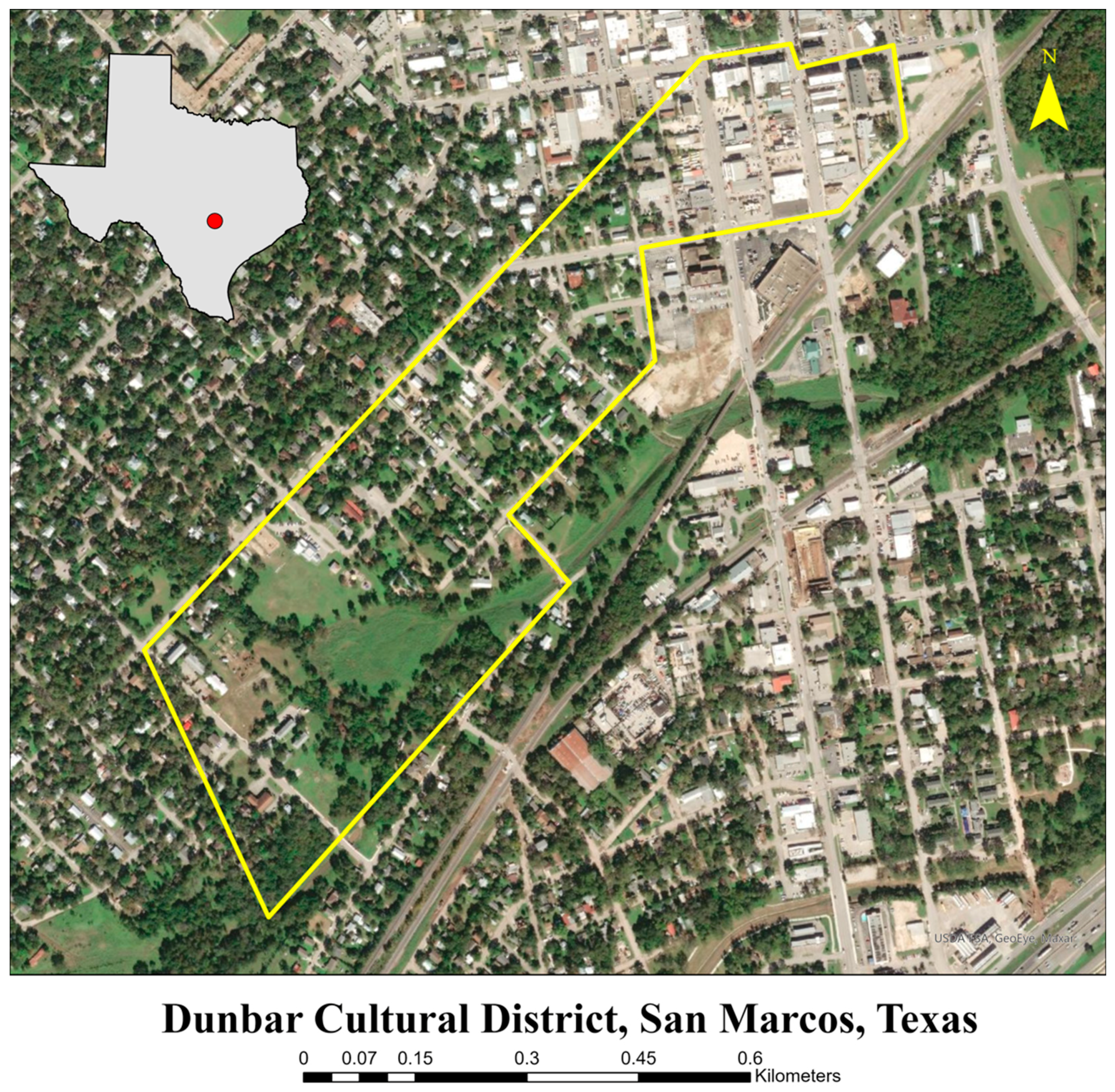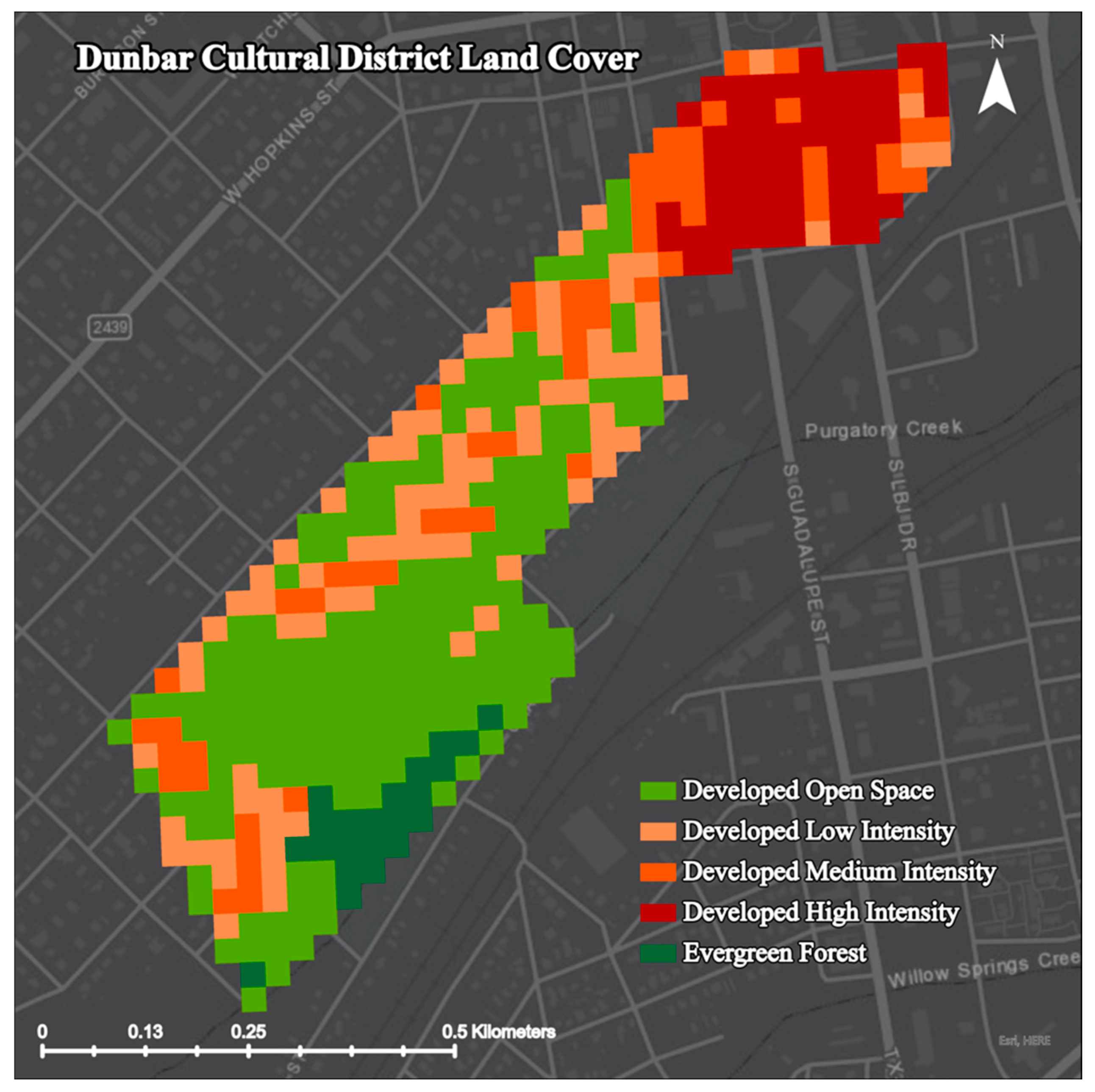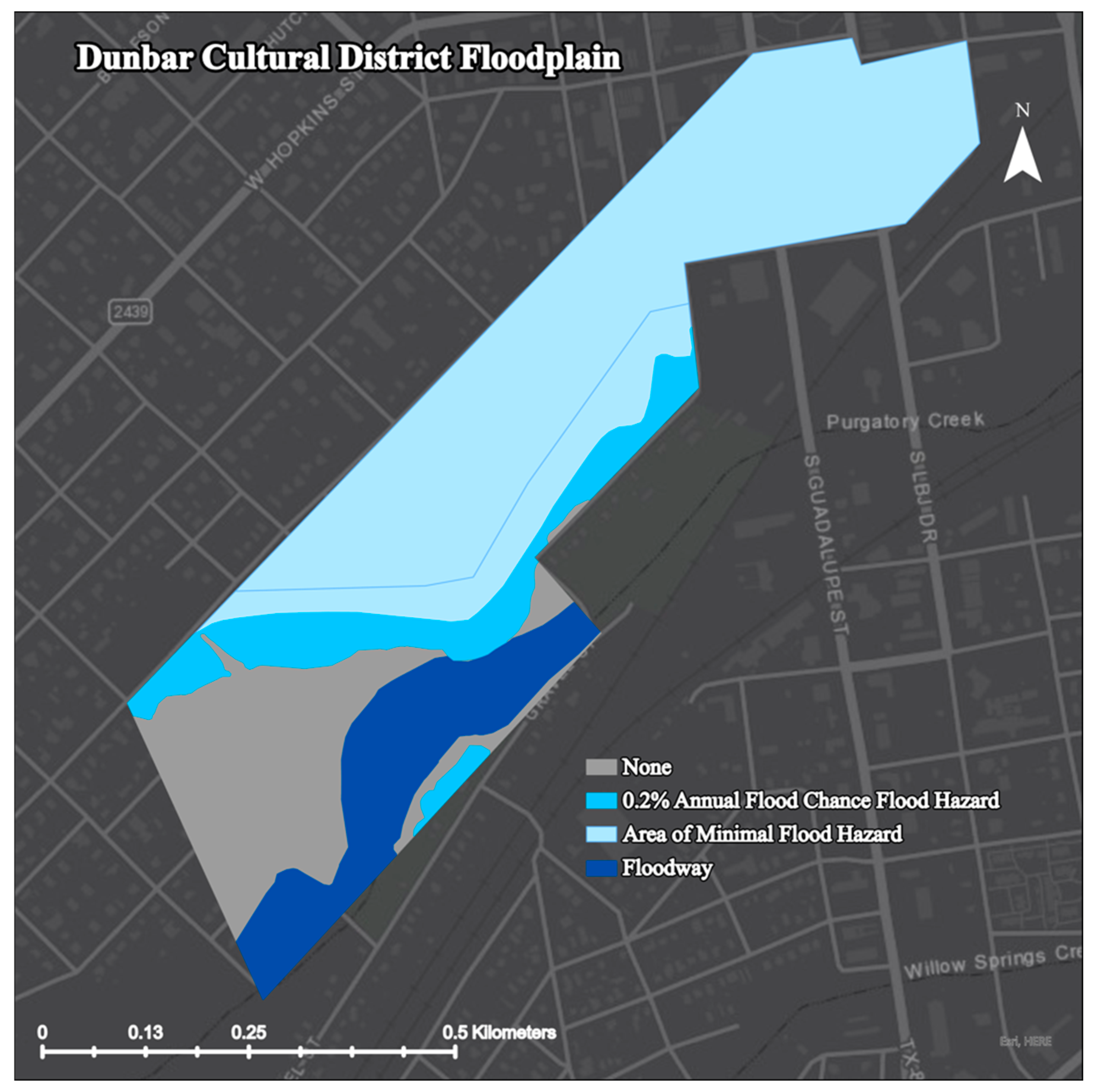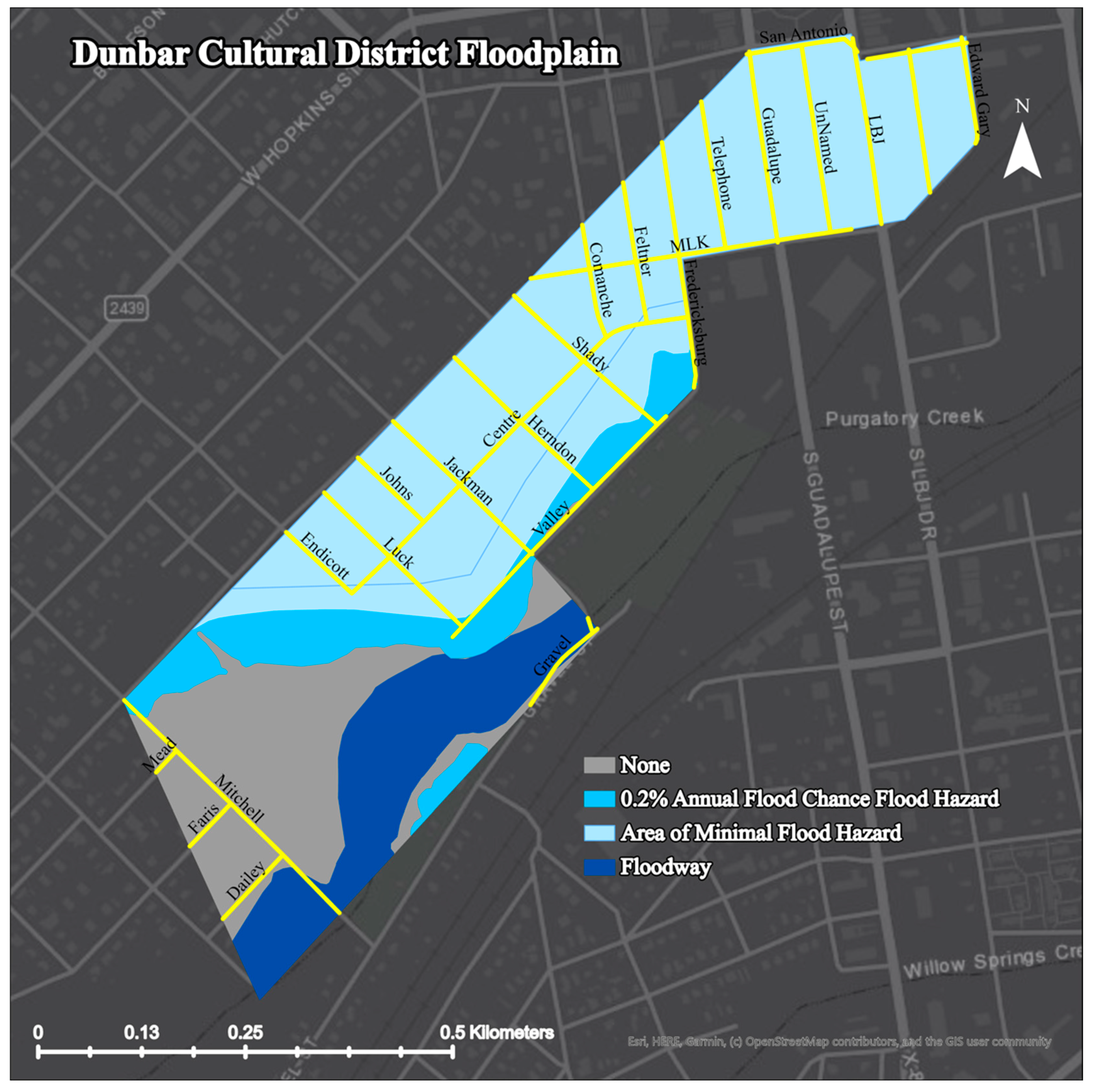African American Experiences in the Historic Dunbar Neighborhood in San Marcos, Texas: A Case Study of Counter-Life Stories
Abstract
1. Introduction
2. Literature Review
2.1. Oral Tradition and Historical Research within African American Communities
Scholars have recognized that utilizing oral tradition and oral history is critical to attempting African American historical research and scholarship (Alexander and Austin 2010). This notion has primarily been due to the lack of representation of the African American community within historical literature and scholarly discourse until recent decades. The political, economic, and social repression of the African American community has also historically played a role in how oral traditions are the primary medium of how history is transmitted within the African American community.fundamental to understanding the African American experience’s essence. Indeed, we maintain that no exploration of African American life or political consciousness is complete without analyzing and discussing oral culture and history of giving voice to the people themselves.(p. 171)
2.2. The Dominant Perspective of the History of the Dunbar Neighborhood
2.3. Counter-History Account
3. Methods
3.1. Counter-Life Story Interview Protocol
3.2. Maps of the Dunbar Neighborhood
4. Results
4.1. History of Racism and Slavery
Slavery
Segregation
Integration
Flooding as Environmental Racism
4.2. Impact of Environmental and Social Racism
Flood Relocation
Gentrification
Black-Owned Businesses
Government and Aid Programs
4.3. Rebuilding and Restoring the Community
Faith
Sense of Place
Recommendations for Revitalization
“They don’t take the time—to, I guess, to kinda bond and get those type of—of relationships that we—that the older generation had back—back when I was growing up. I’d still like to see it be the Dunbar—be known or have things where people can read its history—of the Dunbar that would—that—that it originally came from, even if it’s not all of it can be preserved. I would like to see that it—that the neighborhood if it does change, changes in a way that whoever comes in, they would know about the history of where—what was in the past.And then maybe try to preserve—try to preserve as much as we—as much as we can. The restored community center where people in the neighborhood could either use for whatever events they wanted to have or have, um, have things there for that would be for the community. Where they could be updated on things going on in the community, where they could, um, they could have community events—weddings or whatever they needed to do. But for—things for the community that were—that would be centered around that community and this area. The Dunbar area. Sometimes you can’t—you can’t stop the change. Um, Dunbar’s—they got—I’d like to see the original place stay there in the end, but then again, I know that even they’re doing construction. It seems a block is building a new road. People are going to—it’s gonna be different, and I can’t stop that change unless someone just ha—halted. I mean, we came back to live. Say I came back to live over in that area, um, I could not see it, but I could—you know? But, uh, i—I mean, there’s nothing there that I could live in now. I would have to build something new if I came back here—to the neighborhood.”
“I think helping people, Black people you’re talking about, realize that they have potential, that they have skills, that they can do things and become authority like you are…and you know if you can help people gain confidence in themselves and learn how to do things if they didn’t know how before or though. So, they realize that they can do things and they, they can do great things.”
5. Conclusions
Author Contributions
Funding
Conflicts of Interest
Appendix A. Timeline of Dunbar Events
| 1850 | Joseph Cephas arrived in San Marcos after being purchased by William Thompson at a slave market in New Orleans, LA. |
| Census indicated Hays County had 128 slaves out of 378 residents. | |
| 1858 | A School Board of Examiners was formed to organize the “Negro” or “Colored” School * |
| 1860 | 1860 Schedule-2 Slave Census for Hays County reported 94 persons owned slaves, equating to 797 slaves in the entire county. |
| 1863 | Emancipation Proclamation issued by President Abraham Lincoln on 1 January 1863. |
| 1865 | 13th Amendment abolished slavery on 31 January 1865. |
| Congress established the Bureau of Refugees, Freedmen, and Abandoned Lands (Freedmen’s Bureau) on 3 March 1865. | |
| Civil War ended on 9 April 1865. | |
| Juneteenth announced in Texas on 19 June 1865 (Also called Freedom Day, Jubilee Day, Liberation Day, or Emancipation Day). | |
| 1866 | Colored Baptist Church Zion (Guadalupe Street) was founded and constructed by Rev. Moses John (original historic First Baptist Church). |
| 1868 | Freedman’s Bureau founded the Freedmen’s School (initial Colored school) at a church. |
| 1873 | Ku Klux Klan burned Colored Baptist Church Zion (Guadalupe Street). |
| Calaboose jail house (Comal/W. Martin Luther King Street) was constructed as Hays County’s first official jailhouse. | |
| 1875 | Wesley Chapel African Methodist Episcopal Church was founded. |
| 1877 | “Negro” School was organized on 13 January 1877 *. |
| 1879 | Wesley Chapel A.M.E. Church (Fredericksburg Street) was constructed and operated a Freedmen’s school *. |
| 1880s | Freedmen’s school was destroyed by fire. |
| The original Dunbar school building was constructed for Anglo children in San Marcos, but was later moved into the Dunbar neighborhood. | |
| 1883 | Greater Bethel Baptist Church (Centre Street) was constructed. |
| 1884 | Ulysses Cephas was born in San Marcos to Elizabeth Allen Cephas and her husband Joseph Cephas on 13 June 1884. |
| 1885 | Calaboose was repurposed as a community recreation center and primary location for U.S.O. meetings after World War II. |
| 1884–1952 | Cephas House was occupied. |
| 1893 | The Census recorded Black-owned property purchased by five individuals to purchase land for a cemetery in 1893 to dispose of deceased persons outside of the floodplain properly. |
| 1908 | Old First Baptist Church (219 W. Martin Luther King Street) was rebuilt after K.K.K. fire. |
| 1920s | Cephas built a home for him and his wife on 217 Comal St. (M.L.K. St). |
| 1924 | Ulysses Cephas became a church trustee at Old First Baptist Church. |
| 1954 | Calaboose converted again into a community center. |
| 1960s | Schools were integrated in 1961 or 1962. |
| 1961 | The school was officially named Dunbar School by the school board. |
| 1964 | Jackson Chapel United Methodist Church (Centre Street) was constructed. |
| 1970s | Worst flooding in the Purgatory Creek watershed. |
| Urban Renewal entered the neighborhood. | |
| “The Beat” closed down. | |
| 1990 | Calaboose African American History Museum (200 W. Martin Luther King Drive) was made a landmark by Johnnie Armstead. |
| 1996 | Historical Resources Survey by City of San Marcos (Newlan Knight & Associates). |
| 1997 | Calaboose was made a museum. |
| 2003 | City of San Marcos bought Cephas house, Dunbar recognized as a historic district. |
| 2004 | Dunbar School named as a historical landmark. |
Appendix B. Maps of Dunbar Neighborhood




Appendix C. NVivo 12 Code Book (Node List) Sample
| Node/Code |
| 1. Life in the Dunbar community |
| Challenges |
| Dunbar had always been a Colored neighborhood |
| Interracial coexistence between Blacks, Hispanics, and Whites |
| Safety |
| Very little crime in Dunbar |
| Picking cotton as a young child |
| Playing on father’s farm and creek |
| Recalling growing up on father’s farm |
| Recalling moving to Dunbar |
| Community assets |
| Black American Legion building |
| Black grocery store |
| Blacksmiths and barber shops |
| Camaraderie in the community |
| Unique Black history and culture—Being Black |
| Dunbar commercial life |
| African American Blacksmiths |
| African American barber shop |
| African American businesses down M.L.K. street |
| African American businesses for African Americans |
| African American cab company and cafe |
| Businesses as community centers |
| Spanish grocery store |
| Employment |
| African American and Hispanic jobs |
References
- Adriansen, Hanne Kristine. 2012. Timeline interviews: A tool for conducting life history research. Qualitative Studies 3: 40–55. [Google Scholar] [CrossRef]
- Albiges, Marie. 2018. Group Seeks to Turn Historically Black Dunbar Neighborhood in San Marcos into Official Cultural District. Available online: https://communityimpact.com/austin/san-marcos-buda-kyle/arts-entertainment/2018/05/01/historically-Black-dunbar-neighborhood-in-san-marcos-looks-to-turn-into-official-cultural-district (accessed on 28 September 2020).
- Alexander, Leslie, and Curtis J. Austin. 2010. Africana studies and oral history: A critical assessment. In African American Studies. Edited by Jeanette R. Davidson. Edinburgh: Edinburgh University Press, pp. 171–93. Available online: http://www.jstor.org/stable/10.3366/j.ctt1g0b6m8.13 (accessed on 28 September 2020).
- Ashford, Shetay Nicole. 2016. Our Counter-Life Herstories: The Experiences of African American Women Faculty in U.S. Computing Education (Publication No. 10108024). Ph.D. dissertation, University of South Florida, Tampa, FL, USA. [Google Scholar]
- Ashford-Hanserd, Shetay. 2018. #ReclaimDunbar: Reclaiming Lost Voices in Historic Communities of Color [Video File]. Available online: https://youtu.be/dtoFVWjGOPs (accessed on 28 September 2020).
- Ashford-Hanserd, Shetay. 2020. Counter-life herstories: Black women faculty pathways in U.S. P-20 computing education. Journal of Women and Minorities in Science and Engineering. [Google Scholar] [CrossRef]
- Bagley, Carl, and Ricardo Castro-Salazar. 2012. Critical arts-based research in education: Performing undocumented historias. British Educational Research Journal 38: 239–60. [Google Scholar] [CrossRef]
- Batura, Sean. 2010. Old First Baptist Church Supporters Hope for Community Center. Available online: http://smmercury.com/2010/08/03/old-first-baptist-church-supporters-hope-for-community-center/ (accessed on 28 September 2020).
- Billingsley, Andrew, and Cleopatra Howard Caldwell. 1991. The Church, the family, and the school in the African American community. The Journal of Negro Education 60: 427–40. [Google Scholar] [CrossRef]
- Brantley, Constunce. 2018. Museum Celebrates African-American History in San Marcos. University Star. Available online: https://universitystar.com/23372/life_and_arts/museum-celebrates-african-american-history-in-san-marcos/ (accessed on 28 September 2020).
- Braun, Virginia, and Victoria Clarke. 2006. Using thematic analysis in psychology. Qualitative Research in Psychology 3: 77–101. [Google Scholar] [CrossRef]
- Buckley, Jordan. 2019. Let’s Acknowledge the Role of Slave Labor. Available online: https://www.sanmarcosrecord.com/opinions/let%E2%80%99s-acknowledge-role-slave-labor (accessed on 28 September 2020).
- Butler, David R. 2016. Images of America: San Marcos. Charleston: Arcadia Publishing. [Google Scholar]
- Click, Sawyer, and May Olvera. 2018. Community Rallies to Save Historic Old First Baptist Church. Available online: https://universitystar.com/26501/news/community-rallies-to-save-historic-old-first-baptist-church/ (accessed on 28 September 2020).
- Closson, Rosemary B. 2010. Critical race theory and adult education. Adult Education Quarterly 60: 261–83. [Google Scholar] [CrossRef]
- Cole, Ardra L., and J. Gary Knowles. 2001. Lives in Context: The Art of Life History Research. Lanham: Rowman Altamira. [Google Scholar]
- Creswell, John W. 2014. Research Design: Qualitative, Quantitative, and Mixed Methods Approaches, 4th ed. Thousand Oaks: SAGE Publication. [Google Scholar] [CrossRef]
- Crouch, Barry A. 1999. The Freedmen’s Bureau and Black Texan. Austin: University of Texas Press. [Google Scholar]
- Crouch, Barry A., and Larry Madaras. 2007. The Dance of Freedom: Texas African Americans during Reconstruction. Austin: University of Texas Press. [Google Scholar]
- Delgado, Richard. 1989. Storytelling for oppositionists and others: A plea for narrative. Michigan Law Review 87: 2411–41. [Google Scholar] [CrossRef]
- Dunbar Heritage Association. 2018. n.d. Unpublished Document. January.
- First Baptist Church N.B.C. n.d. First Baptist Church N.B.C. History. Available online: https://fbnbc.org/our-history (accessed on 28 September 2020).
- Groundspeak Inc. 2017. 277—Jackson Chapel—San Marcos, TX—Historic United Methodist Sites on Waymarking.com. Available online: https://www.waymarking.com/waymarks/WMKC2Q_277_Jackson_Chapel_San_Marcos_TX (accessed on 28 September 2020).
- Herod, Anna. 2018. Historic First Baptist Church of San Marcos Wins $150,000 Grant for Restoration. Available online: https://communityimpact.com/austin/san-marcos-buda-kyle/city-county/2018/10/29/historic-first-baptist-church-of-san-marcos-wins-150000-grant-for-restoration/ (accessed on 28 September 2020).
- HMdb.org. 2020. Wesley Chapel A.M.E. Available online: https://www.hmdb.org/m.asp?m=149884 (accessed on 28 September 2020).
- Hubain, Bryan S., Evette L. Allen, Jessica C. Harris, and Chris Linder. 2016. Counter-stories as representations of the racialized experiences of students of color in higher education and student affairs graduate preparation programs. International Journal of Qualitative Studies in Education 29: 946–63. [Google Scholar] [CrossRef]
- Johnson, Kate. 2010. Letter to the editor: Save the First Baptist Church. Available online: http://smmercury.com/2010/07/28/letter-to-the-editor-save-the-first-baptist-church/ (accessed on 28 September 2020).
- Kimmel, Jim T. 2006. The San Marcos: A River Story. College Station: Texas A and M University. [Google Scholar]
- Knight Newlan and Associates, Inc. 1996. Historic Resources Survey of the Dunbar and East Guadalupe Neighborhoods. Austin and Buda: Knight, Newlan and Associates, Inc. [Google Scholar]
- O’Rourke, Ciara. 2013. San Marcos Renovating Historic House in First African-American Neighborhood. Statesmen. Available online: https://www.statesman.com/NEWS/20130111/San-Marcos-renovating-historic-house-in-first-African-American-neighborhood (accessed on 28 September 2020).
- Peterson, Bill. 2013. City Restoring Cephas House. Available online: http://smmercury.com/2013/01/08/64073/ (accessed on 28 September 2020).
- Renick, Oren, Randall E. Osborne, and Megan Hamid. 2006. The Ties that Bind. Springfield: The T.M.A. Press. Available online: https://digital.library.txstate.edu/handle/10877/4088 (accessed on 28 September 2020).
- Saldaña, Johnny. 2012. The Coding Manual for Qualitative Researchers. London: Sage. [Google Scholar]
- San Marcos Main Street Program. n.d. The economic impact of the Dunbar neighborhood on the city of San Marcos (unpublished report).
- Solórzano, Daniel G., and Tara J. Yosso. 2002. Critical race methodology: Counter-storytelling as an analytical framework for education research. Qualitative Inquiry 8: 23–44. [Google Scholar] [CrossRef]
- Sonier, Rachel. 2019. Greater Bethel Baptist Celebrates 136 Years. Available online: https://www.sanmarcosrecord.com/features/greater-bethel-baptist-celebrates-136-years (accessed on 28 September 2020).
- Stovall, Frances, Maxine Storm, Louise Simon, Gene Johnson, Dorothy Schwartz, and Dorothy W. Kerbow. 1986. Clear Springs and Limestone Ledges: A history Of San Marcos and Hays County. Austin: Nortex Press. [Google Scholar]
- Texas Historical Commission. 1988. Ulysses Cephas House Application Form for Official Texas Historical Marker. Texas: Texas Historical Commission. [Google Scholar]
- Texas Historical Commission. 1990. The Calaboose Application Form for Official Texas Historical Marker. Austin: Texas Historical Commission, p. 4. [Google Scholar]
- Texas State University. 1996. San Marcos: A guide to a Historic Texas Town. San Marcos: Department of History, Southwest Texas State University. [Google Scholar]
- Van Oudekerke, Rodney. 2011. Historic San Marcos: An Illustrated History, 1st ed. San Antonio: Historical Publishing Network. [Google Scholar]
| Participant | Profile |
|---|---|
| Laura | Black Female: Child at the time of integration, attended Dunbar Elementary prior to integration from 1961 to 1962. |
| Olivia | Black Female: Born 1942 and raised in the Dunbar community. |
| Paula | Black Female: Still a resident of the Dunbar community, but rising Taxes is an issue/challenge. |
| Meredith | Black Female: Attended the Dunbar school growing up. |
| Robert | Black Male: Grew up in a Black-only neighborhood—a Dunbar resident. |
| Molly | White Female: Moved into San Marcos, TX, in 1966 and is familiar with the Dunbar community. |
| Morgan | Black Female: Born and raised in San Marcos, TX, and attended the Colored school. |
| Fred | Black Male: Would like to see Dunbar’s history carried into the future. |
| Laura | Olivia | Paula | Meredith | Molly |
|---|---|---|---|---|
| We had a mixture. I went to Dunbar. I might’ve went to the second, no more than the third grade, before integration in ’61 or ’62. | We didn’t all come here as slaves. Some of us were slaveowners. | I went to Dunbar [H.S.] for two weeks. Quite the reunion. | even though, uh, there was a mixture, everybody knew their boundaries | No, I do not think there was ever any slavery here. I think that volunteers could be brought to San Marcus to build houses for the people. |
| Laura | Olivia | Paula | Meredith | Fred |
|---|---|---|---|---|
| Lost their homes or kids sold it. | There were many educated people and -business owners and successful people in Dunbar. | I said each year it seemed like they’re going up, you know, and, and it’s high, but you gotta do what you gotta do. | Homes that were occupied by nothing but Black people are now Hispanics or whites are coming in. | A while back, uh the flood took away, uh—uh I think it was two little—two little girls’ lives. When Gary Job Corps came in, it changed the whole dynamics of this town. |
| Laura | Olivia | Meredith | Morgan | Molly |
|---|---|---|---|---|
| I still attended Jackson Chapel United Methodist Church. I still came to Church, | We all had service at the Church. God is with us. He’s taking care of us. I guess because a lot of us are getting older | She taught at San Marcos Baptist Academy—she said, “You can. When you finish that one, you can come back and—and get another book.” | The Bethel Church (Second Baptist Church) grandparents possibly like rebuild structures. | When I helped somebody else, I can see how it changes their life or how happy it makes them or whatever |
| Laura | Meredith | Fred | Molly |
|---|---|---|---|
| I’d still like it to be the Dunbar—be known or have things where people can read the history of it—of the Dunbar that would—that it originally came from, even if not all of it can be preserved. | We need to see the beautification of it. | Your choice is my rejoice. | I think helping people, Black people you’re talking about helping them realize that they have potential, that they have skills. If you can help people gain confidence in themselves and learn how to do things if they didn’t know how before or though |
© 2020 by the authors. Licensee MDPI, Basel, Switzerland. This article is an open access article distributed under the terms and conditions of the Creative Commons Attribution (CC BY) license (http://creativecommons.org/licenses/by/4.0/).
Share and Cite
Ashford-Hanserd, S.; Sarmiento, E.; Myles, C.C.; Rayburn, S.W.; Roundtree, A.K.; Hayton, M.-P.; Ybarra, E.; Benitez, S.; Clifford, T.M.; Pierce, C.; et al. African American Experiences in the Historic Dunbar Neighborhood in San Marcos, Texas: A Case Study of Counter-Life Stories. Soc. Sci. 2020, 9, 177. https://doi.org/10.3390/socsci9100177
Ashford-Hanserd S, Sarmiento E, Myles CC, Rayburn SW, Roundtree AK, Hayton M-P, Ybarra E, Benitez S, Clifford TM, Pierce C, et al. African American Experiences in the Historic Dunbar Neighborhood in San Marcos, Texas: A Case Study of Counter-Life Stories. Social Sciences. 2020; 9(10):177. https://doi.org/10.3390/socsci9100177
Chicago/Turabian StyleAshford-Hanserd, Shetay, Eric Sarmiento, Colleen C. Myles, Steven W. Rayburn, Aimee Kendall Roundtree, Mary-Patricia Hayton, Edward Ybarra, Sarai Benitez, Theresa M. Clifford, Christopher Pierce, and et al. 2020. "African American Experiences in the Historic Dunbar Neighborhood in San Marcos, Texas: A Case Study of Counter-Life Stories" Social Sciences 9, no. 10: 177. https://doi.org/10.3390/socsci9100177
APA StyleAshford-Hanserd, S., Sarmiento, E., Myles, C. C., Rayburn, S. W., Roundtree, A. K., Hayton, M.-P., Ybarra, E., Benitez, S., Clifford, T. M., Pierce, C., Williams, C. D., & Maleki, S. (2020). African American Experiences in the Historic Dunbar Neighborhood in San Marcos, Texas: A Case Study of Counter-Life Stories. Social Sciences, 9(10), 177. https://doi.org/10.3390/socsci9100177





